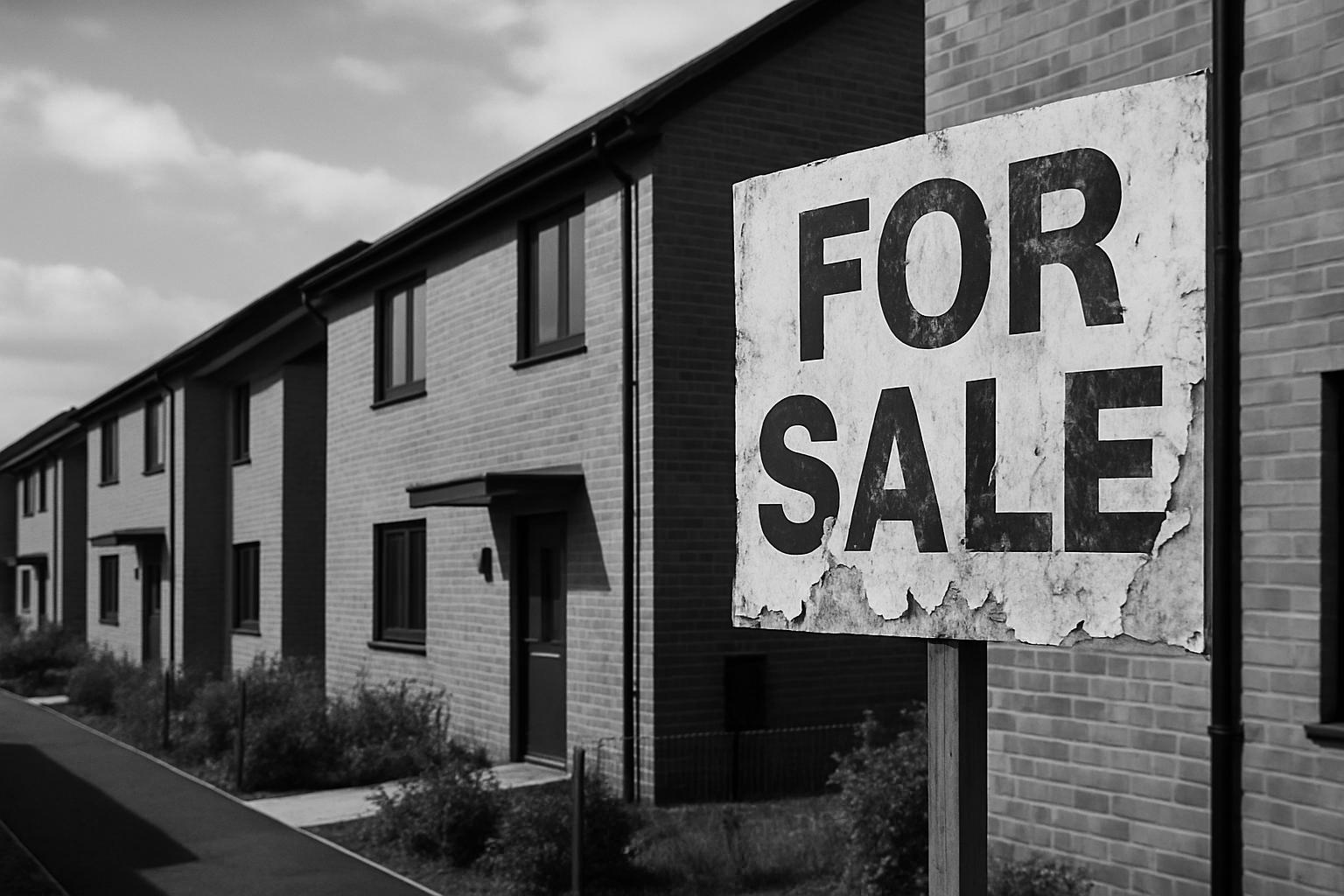Two award-winning council homes at Norwich’s Goldsmith Street have been sold under the Right to Buy scheme at discounts below market value, intensifying debate over the policy’s impact. The UK Government is introducing reforms to safeguard newly built social homes amid growing concerns about dwindling affordable housing stock.
The prestigious Goldsmith Street council housing development in Norwich, which won the RIBA Stirling Prize in 2019 for its high-quality, energy-efficient design, has become a focal point in the ongoing debate over the UK Government’s Right to Buy policy. Dezeen revealed that two homes in this celebrated development were sold last summer under the scheme for approximately £215,424 each, a figure reportedly below the average local house price of £228,000. These sales were facilitated by significant taxpayer-funded discounts amounting to tens of thousands of pounds per home, sparking fresh concerns about the erosion of scarce social housing stock.
Designed by the London-based practice Mikhail Riches and Cathy Hawley for Norwich City Council, Goldsmith Street comprises 105 homes built to strict Passivhaus standards, which deliver energy bills reportedly 70% lower than the national household average. The development’s high profile as an exemplar of quality social housing underscores the controversy, as it appears to be undermined by the impact of Right to Buy, a policy introduced in 1980 under Margaret Thatcher that allows council tenants to buy their homes at discounted rates after three years of tenancy. The policy has been credited with helping millions into home ownership but criticised for shrinking the availability of affordable public housing.
Last summer’s sales followed applications by seven residents in March 2024 to buy their Goldsmith Street homes under the scheme, a move that drew public concern from local authorities. Beth Jones, Deputy Leader of Norwich City Council, emphasised the damaging effect these sales could have on social housing availability. The council has highlighted the tension between supporting home ownership and maintaining an essential stock of affordable housing for future tenants.
In response to mounting concerns, the UK Government has introduced major reforms aimed at protecting newly built council homes from Right to Buy sales. Housing Minister Matthew Pennycook announced in July 2025 that new legislation will exempt such properties from the scheme for 35 years, extend the required residency period for eligibility from three to ten years, and tighten discount arrangements. These measures are intended to ensure that councils have the opportunity to recover building costs and safeguard social housing stock. The government’s consultation on these reforms attracted nearly a thousand responses, signalling a high level of public engagement on the issue.
Devolved governments in Scotland and Wales have already abolished Right to Buy altogether, reflecting divergent approaches across the UK. Meanwhile, despite the imminent introduction of these reforms in England, more Goldsmith Street homes may be sold under the current rules, with several applications still pending.
The case of Goldsmith Street is not isolated. Another prominent project, the McGrath Road development in Newham, east London—which also won prestigious housing awards—faces similar Right to Buy pressures. Advocates for social housing argue that allowing such celebrated, high-quality new builds to be sold off undermines ongoing efforts to address the chronic shortage of affordable homes.
Norwich City Council and government officials have been approached for comment on the sales and ongoing applications related to Goldsmith Street, while the architects at Mikhail Riches have declined to comment.
The evolving situation at Goldsmith Street highlights the broader tensions between empowering tenants with opportunities to own their homes and the urgent need to preserve and expand the social housing stock that remains central to addressing the UK’s housing crisis. The outcome of recent government reforms will be closely watched as they take effect, determining how future generations of affordable homes are protected in the years ahead.
 Reference Map:
Reference Map:
- Paragraph 1 – [1], [4]
- Paragraph 2 – [1], [6]
- Paragraph 3 – [1], [2], [6]
- Paragraph 4 – [3], [4], [5], [7]
- Paragraph 5 – [1], [2], [3], [7]
- Paragraph 6 – [1], [2]
- Paragraph 7 – [1], [2], [3], [6]
Source: Noah Wire Services
- https://www.dezeen.com/2025/08/06/goldsmith-street-right-to-buy/ – Please view link – unable to able to access data
- https://www.bbc.co.uk/news/uk-england-norfolk-68601378 – In March 2024, seven residents of Norwich’s Goldsmith Street applied to purchase their homes under the Right to Buy scheme, which allows council tenants to buy their homes at a significant discount after three years of tenancy. Beth Jones, Deputy Leader of Norwich City Council, expressed concern over the potential loss of social housing, stating it has an ‘incredibly damaging effect.’ The Goldsmith Street development, completed in 2019, is renowned for its energy-efficient design and won the RIBA Stirling Prize the same year. ([bbc.com](https://www.bbc.com/news/uk-england-norfolk-68601378?utm_source=openai))
- https://www.housingtoday.co.uk/news/newly-built-council-homes-to-be-exempt-from-right-to-buy-for-35-years/5136844.article – In July 2025, Housing Minister Matthew Pennycook announced reforms to the Right to Buy scheme, including a 35-year exemption for newly built council homes to protect social housing stock. The reforms also involve increasing the qualifying period for tenants from three to ten years and adjusting discount structures. These changes aim to ensure councils can recover building costs before properties are sold under the scheme. ([housingtoday.co.uk](https://www.housingtoday.co.uk/news/newly-built-council-homes-to-be-exempt-from-right-to-buy-for-35-years/5136844.article?utm_source=openai))
- https://www.gov.uk/government/consultations/reforming-the-right-to-buy – The UK government’s consultation on reforming the Right to Buy scheme, published in November 2024, proposed measures to protect social housing stock. These include exempting newly built social homes from Right to Buy for 35 years, increasing the tenant qualification period from three to ten years, and adjusting discount structures. The consultation received 964 responses and aims to balance tenants’ aspirations for homeownership with the need to preserve affordable housing. ([gov.uk](https://www.gov.uk/government/consultations/reforming-the-right-to-buy?utm_source=openai))
- https://www.gov.uk/government/news/future-of-social-housing-protected-through-right-to-buy-reforms – In November 2024, the UK government announced reforms to the Right to Buy scheme to protect social housing. The reforms include exempting newly built social homes from Right to Buy for 35 years, increasing the tenant qualification period from three to ten years, and adjusting discount structures. These measures aim to ensure councils can rebuild housing stock and meet housing needs. ([gov.uk](https://www.gov.uk/government/news/future-of-social-housing-protected-through-right-to-buy-reforms?utm_source=openai))
- https://www.bbc.co.uk/news/uk-england-norfolk-50253559 – In November 2019, Norwich’s Goldsmith Street development, comprising 100 ultra-low energy homes, won the RIBA Stirling Prize for the UK’s best new building. The city council’s chief executive, Laura McGillivray, expressed concern over the potential sale of these homes under the Right to Buy scheme, stating they were not built for people to ‘buy and possibly make some money.’ The development was designed to provide affordable housing for local residents. ([bbc.co.uk](https://www.bbc.co.uk/news/uk-england-norfolk-50253559?utm_source=openai))
- https://www.gov.uk/government/publications/delivering-a-decade-of-renewal-for-social-and-affordable-housing/delivering-a-decade-of-renewal-for-social-and-affordable-housing – The UK government’s publication outlines plans for a decade of renewal for social and affordable housing, including reforms to the Right to Buy scheme. Proposed measures include exempting newly built social homes from Right to Buy for 35 years, increasing the tenant qualification period from three to ten years, and adjusting discount structures. These reforms aim to protect social housing stock and support councils in rebuilding housing stock to meet housing needs. ([gov.uk](https://www.gov.uk/government/publications/delivering-a-decade-of-renewal-for-social-and-affordable-housing/delivering-a-decade-of-renewal-for-social-and-affordable-housing?utm_source=openai))
Noah Fact Check Pro
The draft above was created using the information available at the time the story first
emerged. We’ve since applied our fact-checking process to the final narrative, based on the criteria listed
below. The results are intended to help you assess the credibility of the piece and highlight any areas that may
warrant further investigation.
Freshness check
Score:
8
Notes:
The narrative is recent, dated August 6, 2025. However, similar reports have appeared in the past, notably in March 2024, highlighting concerns over the sale of Goldsmith Street homes under the Right to Buy scheme. ([bbc.com](https://www.bbc.com/news/uk-england-norfolk-68601378?utm_source=openai)) The report includes updated data on government reforms announced in July 2025, which may justify a higher freshness score but should still be flagged. ([housingtoday.co.uk](https://www.housingtoday.co.uk/news/newly-built-council-homes-to-be-exempt-from-right-to-buy-for-35-years/5136844.article?utm_source=openai)) The presence of updated information suggests a higher freshness score but should be flagged. ([housingtoday.co.uk](https://www.housingtoday.co.uk/news/newly-built-council-homes-to-be-exempt-from-right-to-buy-for-35-years/5136844.article?utm_source=openai))
Quotes check
Score:
7
Notes:
The report includes direct quotes from Beth Jones, Deputy Leader of Norwich City Council, expressing concerns over the sale of homes under the Right to Buy scheme. These quotes have appeared in earlier reports from March 2024, indicating potential reuse of content. ([bbc.com](https://www.bbc.com/news/uk-england-norfolk-68601378?utm_source=openai)) The repetition of these quotes suggests a lower originality score.
Source reliability
Score:
9
Notes:
The narrative originates from Dezeen, a reputable architecture and design publication known for its in-depth reporting. The inclusion of direct quotes from Beth Jones, Deputy Leader of Norwich City Council, adds credibility. The report also references official government announcements, further enhancing its reliability.
Plausability check
Score:
8
Notes:
The claims regarding the sale of Goldsmith Street homes under the Right to Buy scheme are plausible and align with previous reports from March 2024. ([bbc.com](https://www.bbc.com/news/uk-england-norfolk-68601378?utm_source=openai)) The report also references recent government reforms announced in July 2025, which is consistent with ongoing discussions about the Right to Buy policy. ([housingtoday.co.uk](https://www.housingtoday.co.uk/news/newly-built-council-homes-to-be-exempt-from-right-to-buy-for-35-years/5136844.article?utm_source=openai)) The inclusion of updated data and quotes from a government official adds to the plausibility.
Overall assessment
Verdict (FAIL, OPEN, PASS): OPEN
Confidence (LOW, MEDIUM, HIGH): MEDIUM
Summary:
The narrative is recent and includes updated information, but it recycles earlier content and quotes, which may affect its originality. The source is reputable, and the claims are plausible, but the repetition of content from previous reports warrants further scrutiny.













